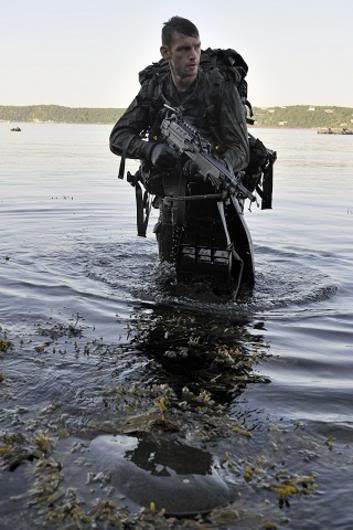Within the Canadian Forces, one component seems particularly misunderstood, both by commanders and by the mainstream public. The Patrol Pathfinders, trained by the Canadian Army Advanced Warfare Centre in Trenton, have a unique but little known function as a vanguard reconnaissance force. Often integrated into regular Canadian Army units, the lack of a visible role for Pathfinder elements in Afghanistan led some to question what value was added by the Patrol Pathfinder program. In this context, misconceptions emerged which suggested that Pathfinders simply duplicated the capabilities of paratroopers.

In truth, the Pathfinders fill a valuable niche in the Canadian Army. After completing an eight-week course that is described as one of the world’s most ‘gruelling’, Pathfinders are able to rapidly deploy into hostile environments from speedboats, helicopters, submarines, and via parachute. Once deployed, they can then operate independently to gather intelligence for commanders on enemy capabilities, prepare sniper positions, and otherwise set conditions favourable to a future advance by a larger military formation. In short, Pathfinders are perfectly suited to what the Canadian Forces refers to as ‘adaptive dispersed operations’ (ADO).
In 2007, the Canadian Army reflected on lessons learned from the mission in Afghanistan and developed a new strategic concept entitled Land Operations 2021. That document defines ADO as “…the ability to conduct coordinated, interdependent, full spectrum actions by widely dispersed teams across the moral, physical and informational planes of the battlespace, ordered and connected within an operational design created to achieve a desired end state.” In the context of a failed state where multiple conflicts have emerged, Pathfinders are essential for commanders who need to make sense of what is happening within their area of operations. While an Unmanned Aerial Vehicle (UAV) could provide some of the surveillance that would otherwise be provided by Pathfinders, such vehicles cannot interact with the environment in a way a human soldier can. Only these soldiers possess the ‘adaptability’ that the Canadian Forces has identified as so key to ADO and future warfare.
Although one could argue that Pathfinders are still not being employed to their full potential in overseas operations, the performance of Pathfinders on Canadian Forces exercises demonstrates how they can match the needs of ADO. During the 2008 edition of Exercise Trillium Response, Pathfinders conducted a suitability assessment of an airstrip near Moosonee, Ontario prior to the arrival of the main body of forces via a CC-130 Hercules transport aircraft. The Pathfinders communicated this information to the commander and provided security during the landing. At Exercise Trident Fury, Pathfinders joined with Royal Canadian Navy clearance divers to establish a beach site for insertion and extraction, established a drop zone for the insertion of a sniper team, and generally performed specialized roles for the commander during this two-week maritime exercise.

Clearly, Pathfinders add value. But to ensure they are utilized appropriately, it is important that the Canadian Forces take two measures. First, it would be worthwhile to establish a dedicated unit for Pathfinders with its own identity. In this sense, Pathfinders would bridge a gap between regular Canadian Army units and the country’s special forces. Such a Pathfinder unit would be admittedly small – typically the Patrol Pathfinder Course produces only ten graduates each year – but it would allow for the development of institutional knowledge and best practices among Pathfinders, going beyond the skills learned through the eight-week course. Second, the Canadian Forces should consider adopting a Force Employment Concept that is specifically concerned with articulating doctrine for commanders on the use of Pathfinders. This would clarify what functions should be assigned to Pathfinders and dispel some of the confusion surrounding reconnaissance roles in the Canadian Army.
Such steps would be in line with those taken by other NATO member states. For example, the British Army has long employed a Pathfinder Platoon, a specialist reconnaissance unit that forms an integral part of 16 Air Assault Brigade. During the Kosovo War, it provided forward air control and formed a defensive screen around Pristina International Airport. Since then, Britain’s Pathfinder Platoon has also served in reconnaissance roles in Sierra Leone, Afghanistan, and Iraq. France has formed a Commando Parachute Group to fulfill a similar function. Each regiment within the 11th Parachute Brigade has one or two of these Commando Parachute Groups within its ranks, making for a total of nineteen such teams. Other countries known to have adopted this model include Belgium, the Netherlands, Portugal, South Africa, and to some extent the United States of America. Canada is essentially unique in its lack of formalization surrounding Pathfinders.
Preserving the status quo in the Canadian Army will only restrict the Pathfinders and prevent their integration into the commander’s toolbox. After surviving such grueling training, Pathfinders deserve to be assigned to missions that harness the fullest extent of their skills and abilities. A Force Employment Concept will help make clear why UAVs are no substitute.




